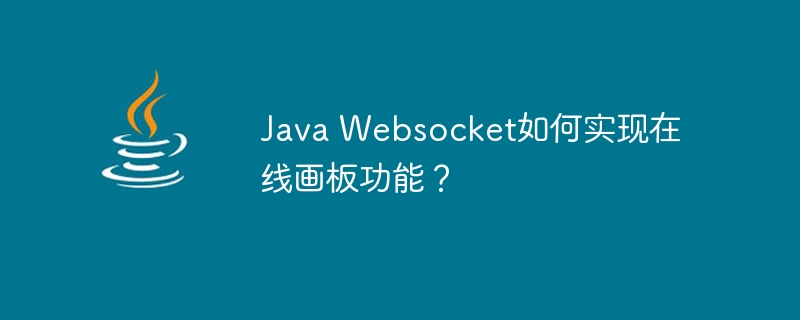
Java Websocket如何实现在线画板功能?
Websocket是HTML5推荐的一种新协议,它可以让客户端和服务器之间可以互相发送消息,实现实时通信。这种协议可以使得我们的在线画板功能变得更加可靠安全且实时。在下面的文章中,我们会介绍如何使用Java Websocket实现在线画板功能,同时附上了一些示例代码来帮助大家理解。
首先,我们需要使用Java Websocket框架,这个框架可以帮助我们快速、简单地实现Websocket协议。下面是一些使用Java Websocket进行消息广播的示例代码:
@ServerEndpoint("/broadcast")
public class Broadcaster {
static Set<Session> sessions = Collections.synchronizedSet(new HashSet<Session>());
@OnMessage
public void onMessage(String message, Session session) throws IOException, EncodeException {
synchronized (sessions) {
for (Session s : sessions) {
if (!s.equals(session)) {
s.getBasicRemote().sendText(message);
}
}
}
}
@OnOpen
public void onOpen(Session session, EndpointConfig config) {
sessions.add(session);
}
@OnClose
public void onClose(Session session, CloseReason reason) {
sessions.remove(session);
}
}在这个示例代码中,我们创建了一个注解为“/broadcast”的Websocket端点。每当有一个新连接时,Websocket服务端就会调用onOpen()方法。该方法会把客户端连接添加到一个集合中。每当一个客户端发送消息时,Websocket服务器会调用onMessage()方法。onMessage()方法遍历所有已连接客户端,然后将消息发送到除消息发送者外的所有客户端。每当一个客户端断开连接时,Websocket服务端调用onClose()方法,该方法会从已连接集合中移除该连接。
接下来,我们需要定义一个画布组件,该组件由前端JavaScript控制,并将管理画板的Java对象与Websocket建立连接:
window.onload = function() {
var canvas = document.getElementById('canvas');
var context = canvas.getContext('2d');
var drawing = false;
var lastX, lastY;
var socket = new WebSocket('<websocket_url>');
socket.onopen = function() {
console.log('Connection opened');
};
socket.onmessage = function(message) {
console.log('Message received: ' + message.data);
var data = JSON.parse(message.data);
drawLine(data.x1, data.y1, data.x2, data.y2, data.color);
};
socket.onerror = function() {
console.log('Error');
};
socket.onclose = function() {
console.log('Connection closed');
};
function startDrawing(event) {
drawing = true;
lastX = event.pageX - canvas.offsetLeft;
lastY = event.pageY - canvas.offsetTop;
}
function stopDrawing() {
drawing = false;
socket.send(JSON.stringify({ eventType: 'stopDrawing' }));
}
function onDrawing(event) {
if (!drawing) return;
var currentX = event.pageX - canvas.offsetLeft;
var currentY = event.pageY - canvas.offsetTop;
drawLine(lastX, lastY, currentX, currentY, '#000');
socket.send(JSON.stringify({ eventType: 'drawing', x1: lastX, y1: lastY, x2: currentX, y2: currentY, color: '#000' }));
lastX = currentX;
lastY = currentY;
}
function drawLine(x1, y1, x2, y2, color) {
context.beginPath();
context.moveTo(x1, y1);
context.lineTo(x2, y2);
context.strokeStyle = color;
context.stroke();
}
canvas.addEventListener('mousedown', startDrawing);
canvas.addEventListener('mouseup', stopDrawing);
canvas.addEventListener('mousemove', onDrawing);
};在这个示例代码中,我们使用WebSocket对象设置onopen,onmessage,onerror和onclose事件来处理客户端JavaScript代码与WebSocket服务端之间的连接和数据处理。在鼠标按下时,客户端代码将调用startDrawing()函数,将后续鼠标移动的轨迹绘制到画布上,并调用socket.send()方法将指令发送给Websocket服务端。服务端接收到客户端发送的指令之后,将这些指令转发给所有已连接的客户端。在鼠标松开时,客户端代码将调用stopDrawing()函数。该函数通知服务端绘制过程已经停止。
最后,我们需要在服务器上配置Websocket。下面是一些Websocket配置示例代码:
<dependencies>
<dependency>
<groupId>javax.websocket</groupId>
<artifactId>javax.websocket-api</artifactId>
<version>1.1</version>
</dependency>
<dependency>
<groupId>org.glassfish.tyrus.bundles</groupId>
<artifactId>tyrus-standalone-server</artifactId>
<version>1.13.1</version>
<scope>provided</scope>
</dependency>
</dependencies>
<build>
<plugins>
<plugin>
<groupId>org.apache.maven.plugins</groupId>
<artifactId>maven-compiler-plugin</artifactId>
<version>3.3</version>
<configuration>
<source>1.8</source>
<target>1.8</target>
</configuration>
</plugin>
<plugin>
<groupId>org.apache.maven.plugins</groupId>
<artifactId>maven-war-plugin</artifactId>
<version>2.1.1</version>
<configuration>
<webResources>
<resource>
<directory>src/main/webapp</directory>
</resource>
</webResources>
</configuration>
</plugin>
<plugin>
<groupId>org.codehaus.mojo</groupId>
<artifactId>exec-maven-plugin</artifactId>
<version>1.6.0</version>
<executions>
<execution>
<goals>
<goal>java</goal>
</goals>
<phase>install</phase>
<configuration>
<mainClass>org.glassfish.tyrus.standalone.Server</mainClass>
<arguments>
<argument>--host</argument>
<argument>localhost</argument>
<argument>--port</argument>
<argument>8090</argument>
<argument>--contextPath</argument>
<argument>/</argument>
<argument>--appBase</argument>
<argument>./src/main/webapp</argument>
<argument>--monitoring</argument>
</arguments>
<classpathScope>compile</classpathScope>
</configuration>
</execution>
</executions>
</plugin>
</plugins>
</build>
<repositories>
<repository>
<id>repo.maven.apache.org</id>
<url>https://repo.maven.apache.org/maven2</url>
</repository>
</repositories>
<profiles>
<profile>
<id>launch</id>
<build>
<plugins>
<plugin>
<groupId>org.codehaus.mojo</groupId>
<artifactId>exec-maven-plugin</artifactId>
<version>1.6.0</version>
<executions>
<execution>
<goals>
<goal>java</goal>
</goals>
<phase>install</phase>
<configuration>
<mainClass>com.test.websocket.Broadcaster</mainClass>
</configuration>
</execution>
</executions>
</plugin>
</plugins>
</build>
</profile>
</profiles>在这个示例代码中,我们使用Maven编译,构建和部署Java Web应用程序,并使用tyrus-standalone-server模块提供WebSocket协议的支持。
我们使用以上代码,可以很容易地实现在线画板功能。这个功能可以用于很多场合,例如医生可以通过它与患者一起更好地分析病情,教育工作者可以通过它与学生共享答案。基于Websocket的在线画板功能可以使这些场合更加便捷和高效。
以上是Java Websocket如何实现在线画板功能?的详细内容。更多信息请关注PHP中文网其他相关文章!
